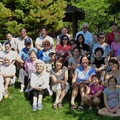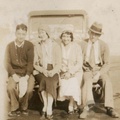The War
A PROJECT FARM was being started at the camp, so Joe volunteered to drive a tractor, since he had experience in driving one back home. He found out quickly, however, that driving a tractor at Tule Lake was nothing like what he had ever done before. The tractors were being used to plant row crops, initially, rutabagas, with rows half a mile long and flat. The soil at Tule Lake was a mix of sand and peat, so the tractor wheels would sink 2 inches into it. It took Joe a while to get used to driving a tractor under those conditions.
Unfortunately, none of the rutabagas could be sold on the open market at that time, although camp administrators would do so later. The only people who could use the rutabagas were the incarcerated Japanese Americans (JAs). But they didn’t know what rutabagas were and wouldn’t eat them. In the end, the ducks and the geese became the sole beneficiaries of 246 acres of rutabagas.
Because so many young men were required for the military, the country needed farm workers. The federal government permitted able-bodied Japanese American men and their families in the camps to apply for leave so that the men could do farm work. Because Kaichi and Itsuno were now elderly, they wanted to accompany Joe and Jean if they were able to obtain the leave.
One of the requirements for obtaining this leave was to provide letters of recommendation from Caucasian Americans. Some of these letters show the regard in which the Kawamoto family was held:
From Jack Dyke:
I have known Kaichi Kawamoto since 1926....Today he has one of the nicest farms and farm homes in the community. He and his family did all the labor and paid as they went.
He educated his children, all thru high school. They have taken part in all community activities such as P.T.A., State Grange and have been citizens of the very highest type.
Kaichi Kawamoto is one of the finest men that I know....
From Minnie A. Stutler:I have known (Itsuno Kawamoto) since she came from Japan....She is very quiet and diffident so I know her mainly by the children she raised and sent to my school....They were well brought up and she wanted them to be as other Americans were in that school. The children were honest, wholesome, and always to be trusted. The home was clean, attractive, and well managed....It nearly broke her heart when she had to go to Tule Lake Center.
From Mrs. George Thomas:I can give (Joe Kawamoto) the best of recommendations. He was born and reared in our community … (and) had a high standing in community affairs, very industrious, and believed to be a very loyal American citizen.
From Mrs. J.W. Dyke:(Jeanette Kawamoto Otsuka was) always well liked in community where she was born & raised. I think she is a loyal American citizen.
From Rev. Ernest A. Reed:I can only say that (the Kawamoto family is) quite a bit above the average as American citizens, and I would have no hesitation in recommending (Alice Kawamoto Okano) for whatever employment she could be given. She was always outstanding in her work here at School.
Leave was granted. The following spring, still under the jurisdiction of the federal government, the Okanos, Otsukas and all four Kawamotos went to Caldwell, Idaho, where Joe, Eddie and Phil did farm work such as harvesting sugar beets and onions.
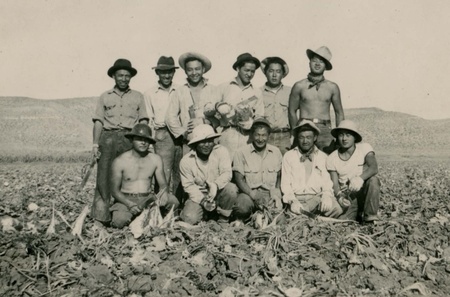
Ironically, one of the farms was owned by a JA family, the Abes, who hadn’t been forced to go to camp because Idaho was outside the West Coast Exclusion Zone. The Abes had seven children, though Mrs. Abe was quite ill and believed she wouldn’t live through the war. She was afraid that if she died, her husband would be unable to cope, especially since their youngest child, Ray, was only 15 months old. At her insistence, Joe and Jean adopted Ray. (Mrs. Abe would recover from her illness, passing away in 1996.)
Even though they were out of camp, the Kawamotos, Otsukas, and Okanos were not yet free. When Phil wanted to visit his sister in the Amache camp, Colorado, while she was recuperating from an emergency appendectomy, he could not leave Idaho until he received permission from the federal government. But life was much better than being in camp.
For example, Joe Kawamoto worked for the Dean family in Idaho for two years. Two of the Deans’ sons and their wives drove to the Kawamoto farm to return with Joe’s and Eddie’s cars, enabling the Kawamotos and Otsukas a little more freedom to move around. Joe would later explain that on their days off, they would drive into the mountains and go fishing and camping and that “it was just like being in a free world.”
In December 1944, the United States Supreme Court, in Endo v. United States, ruled that “concededly loyal” JAs could no longer be incarcerated. Accordingly, the War Department decided that “persons of Japanese ancestry… would be permitted the same freedom of movement throughout the United States as other loyal citizens and law-abiding aliens,” effective January 2, 1945.
On January 13, 1945, the Kawamotos and the Otsukas drove back to Leland. The Kawamotos were welcomed home by almost everyone in the community. Eddie Otsuka, on the other hand, couldn’t find a job in Seattle. At last, the rabbi of the Herzl Congregation gave him a job as a custodian for the synagogue until he was able to find something better. The rabbi had escaped from Nazi Germany several years earlier. He told Eddie, “You and I have been more or less in the same boat.”
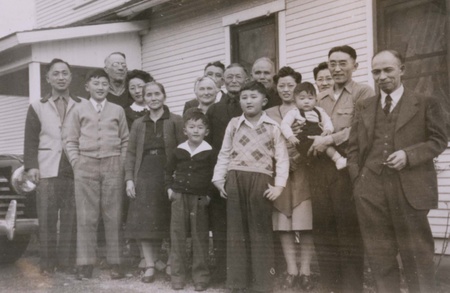
Phil and Alice Okano were initially uncertain whether they wanted to return to Shelton or start over again somewhere in the Midwest. Eventually, they decided to return to Shelton. Alice wanted them to join a local church, but they soon found they were not welcome there.
The Nakatas left Manzanar. Because John no longer had his grocery store and some on Bainbridge Island were opposed to the return of JAs, they decided not to return home, at least for the time being. Instead, they opted to stay on a ranch near Moses Lake. The ranch’s owner, Frank “Tub” Hansen (who would later become a state legislator), provided John with a job and the family with a small cabin.
Perhaps the Nakatas would have stayed in Eastern Washington permanently, had it not been for Millie Woodward, co-owner of the Bainbridge Island Review, the only newspaper that opposed the JA incarceration. Millie knew that the anti-Japanese sentiment on the Island was shared by only a handful of people. On her urging, the Nakatas returned to Bainbridge, just in time for their then youngest son, Wayne, to start kindergarten. On Wayne’s first day of school, young Karen Beierle sat with him on the school bus because her mother wanted to make sure that Wayne would feel welcome.
The Post-War Period
Before the war, presumably because of the lack of refrigeration technology, the Kawamoto farm had produced fermented cream that producers would make into butter. But during the war, the demand for whole milk increased substantially.
So when the Kawamotos returned home, they discovered that the Dykes had built a separate milking house big enough to accommodate four cows. With the two milking machines the farm already had before the war, two cows could be milked while two other cows were being switched out for another pair.
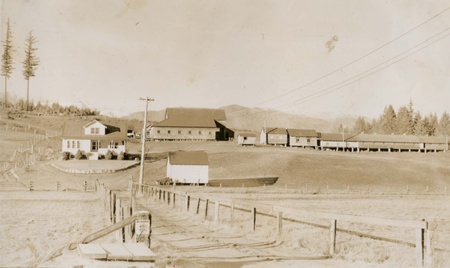
When the war ended, the farm had 15 head of cattle. Eventually the number grew to around 40. The first round of milking started at 6 a.m. The final round began at 5 p.m. Each round lasted roughly 2 hours for all the cows. It wasn’t an easy life.
As Joe’s son Ray would later observe, “Cows rule your life.”
Whole milk from the farm was shipped to Bremerton. The eggs from approximately 480 laying hens were sold through the Washington Cooperative Egg & Poultry Association in Seattle. As the dairy business grew, however, the number of chickens decreased.
Itsuno took a bad fall in 1952, crushing a vertebra. In 1957, Joe seriously injured his right arm while operating a hay baler. He was airlifted to Seattle and hospitalized there for four months and more than once thereafter. Neighbors baled the rest of the hay, and Ray — even though he was only in his early teens — was able to help Jean run the farm.
To be continued ... >>
*This article was originally published in The North American Post on September 22, 2023.
© 2023 Pamela A. Okano



